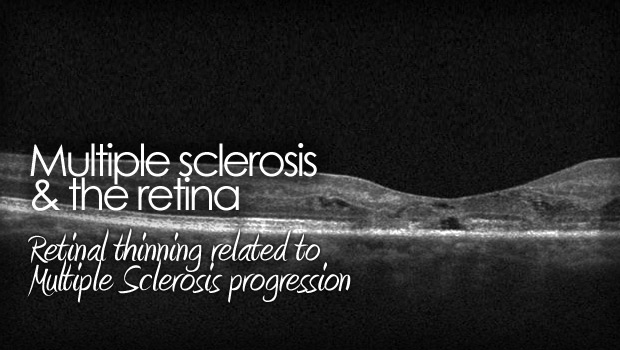Multiple Sclerosis and retinal thinning linked
A study has found that retinal thinning occurs 46% faster in patients with multiple sclerosis Optical Coherence Tomography (OCT) is […]


Multiple Sclerosis and retinal thinning linked
A study has found that retinal thinning occurs 46% faster in patients with multiple sclerosis Optical Coherence Tomography (OCT) is […]
A study has found that retinal thinning occurs 46% faster in patients with multiple sclerosis
Optical Coherence Tomography (OCT) is a technology that has been employed in ophthalmology for more than ten years. The OCT scanner provides eye doctors with a valuable, automated, cross-section representation of the retinal layers in the back, inner wall of the eye.
OCT layer-thickness information is particularly useful in diagnosing and treating eye diseases like glaucoma, macular degeneration and diabetic retinopathy – among many others. Various eye conditions and diseases can cause thickening or thinning of certain layers in the retina. But what about other nervous system diseases, like multiple sclerosis?
Knowing which layers are typically affected, and how, helps eye doctors identify and follow eye disease progression or regression.
Multiple sclerosis is a disease of the central nervous system. Multiple sclerosis attacks and weakens the nerve-insulating myelin, a sheath that surrounds and protects the nerves in the brain and spinal cord.
The retina is considered an “extension of the brain”. It contains about 1.2 million nerve fibers – all protected by this sheath of myelin. So it makes sense that some MS patients, especially those with progressive or relatively newer diagnoses, will show a thinning of these myelin-protected retinal nerve layers on an OCT evaluation.
In a study authored by Peter Calabresi, MD, professor, neurology, and director, MS Center at Johns Hopkins University School of Medicine, researchers measured the thickness of the particular layers in the retina suspected of developing thinning in multiple sclerosis patients.
The OCT measurements were conducted every six months. The patients also underwent a brain MRI annually during the study. The study included 59 healthy patients to compare with 164 multiple sclerosis patients.
During the study, the multiple sclerosis patients demonstrated an average of 46 percent faster thinning of the ganglion cell nerve layers in their retinas compared to the healthy patients.
99% of patients with MS were found to have optic nerve lesions
Doctors were already aware that the eyes are extremely involved in multiple sclerosis. In fact, postmortem data show that 99 percent of patients with multiple sclerosis were found to have optic nerve lesions. It’s not uncommon for MS patients to experience visual symptoms, especially in dark lighting situations, like driving at night. These symptoms are typical of retinal nerve damaging diseases. However, most visual changes and losses are barely noticeable until the damages become significant.
Why are OCT findings significant?
If OCT can be used to predict probable impending progression of MS, physicians can be more alert to the patient and his/her condition and possibly use neuroprotective drugs to attempt to mitigate worsening. OCT probably won’t replace MRI for following patients with MS, but these retinal nerve scans are much less expensive and invasive than the standard MRI tests. They could be a quicker, safer, more economical option to yearly MRI scans.
Doctor’s note: A Multiple Sclerosis specialist should be consulted for any questions or evaluations of MS, not an ophthalmologist. If the MS doctor feels it is necessary, she can work closely with the patient’s ophthalmologist to follow in changes in vision.






